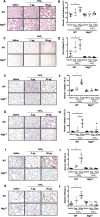Macrophage autophagy protects mice from cerium oxide nanoparticle-induced lung fibrosis
- PMID: 33526046
- PMCID: PMC7852145
- DOI: 10.1186/s12989-021-00398-y
Macrophage autophagy protects mice from cerium oxide nanoparticle-induced lung fibrosis
Abstract
Background: Cerium (Ce) is a rare earth element, rapidly oxidizing to form CeO2, and currently used in numerous commercial applications, especially as nanoparticles (NP). The potential health effects of Ce remain uncertain, but literature indicates the development of rare earth pneumoconiosis accompanied with granuloma formation, interstitial fibrosis and inflammation. The exact underlying mechanisms are not yet completely understood, and we propose that autophagy could be an interesting target to study, particularly in macrophages. Therefore, the objective of our study was to investigate the role of macrophagic autophagy after pulmonary exposure to CeO2 NP in mice. Mice lacking the early autophagy gene Atg5 in their myeloid lineage and their wildtype counterparts were exposed to CeO2 NP by single oropharyngeal administration and sacrificed up to 1 month after. At that time, lung remodeling was thoroughly characterized (inflammatory cells infiltration, expression of fibrotic markers such as αSMA, TGFβ1, total and type I and III collagen deposition), as well as macrophage infiltration (quantification and M1/M2 phenotype).
Results: Such pulmonary exposure to CeO2 NP induces a progressive and dose-dependent lung fibrosis in the bronchiolar and alveolar walls, together with the activation of autophagy. Blockage of macrophagic autophagy protects from alveolar but not bronchiolar fibrosis, via the modulation of macrophage polarization towards M2 phenotype.
Conclusion: In conclusion, our findings bring novel insight on the role of macrophagic autophagy in lung fibrogenesis, and add to the current awareness of pulmonary macrophages as important players in the disease.
Keywords: Alveolar fibrosis - autophagy - macrophage polarization; Nanoparticle.
Conflict of interest statement
No competing interest to declare.
Figures







Similar articles
-
Effects of amorphous silica coating on cerium oxide nanoparticles induced pulmonary responses.Toxicol Appl Pharmacol. 2015 Oct 1;288(1):63-73. doi: 10.1016/j.taap.2015.07.012. Epub 2015 Jul 22. Toxicol Appl Pharmacol. 2015. PMID: 26210349 Free PMC article.
-
Cerium oxide nanoparticle-induced pulmonary inflammation and alveolar macrophage functional change in rats.Nanotoxicology. 2011 Sep;5(3):312-25. doi: 10.3109/17435390.2010.519835. Epub 2010 Oct 6. Nanotoxicology. 2011. PMID: 20925443
-
The acute pulmonary and thrombotic effects of cerium oxide nanoparticles after intratracheal instillation in mice.Int J Nanomedicine. 2017 Apr 10;12:2913-2922. doi: 10.2147/IJN.S127180. eCollection 2017. Int J Nanomedicine. 2017. PMID: 28435267 Free PMC article.
-
Influence of agglomeration of cerium oxide nanoparticles and speciation of cerium(III) on short term effects to the green algae Chlamydomonas reinhardtii.Aquat Toxicol. 2014 Jul;152:121-30. doi: 10.1016/j.aquatox.2014.03.027. Epub 2014 Apr 5. Aquat Toxicol. 2014. PMID: 24747084
-
The role of autophagy in fibrosis: Mechanisms, progression and therapeutic potential (Review).Int J Mol Med. 2025 Apr;55(4):61. doi: 10.3892/ijmm.2025.5502. Epub 2025 Feb 14. Int J Mol Med. 2025. PMID: 39950330 Free PMC article. Review.
Cited by
-
Harnessing reactive oxygen/nitrogen species and inflammation: Nanodrugs for liver injury.Mater Today Bio. 2022 Feb 8;13:100215. doi: 10.1016/j.mtbio.2022.100215. eCollection 2022 Jan. Mater Today Bio. 2022. PMID: 35198963 Free PMC article.
-
Atg5 deficiency in macrophages protects against kidney fibrosis via the CCR6-CCL20 axis.Cell Commun Signal. 2024 Apr 9;22(1):223. doi: 10.1186/s12964-024-01600-2. Cell Commun Signal. 2024. PMID: 38594728 Free PMC article.
-
miR-130a-3p enhances autophagy through the YY1/PI3K/AKT/mTOR signaling pathway to regulate macrophage polarization and alleviate diabetic retinopathy.J Diabetes Investig. 2025 Mar;16(3):392-404. doi: 10.1111/jdi.14381. Epub 2024 Dec 13. J Diabetes Investig. 2025. PMID: 39668747 Free PMC article.
-
The role of PD-1/PD-L1 axis in idiopathic pulmonary fibrosis: Friend or foe?Front Immunol. 2022 Dec 5;13:1022228. doi: 10.3389/fimmu.2022.1022228. eCollection 2022. Front Immunol. 2022. PMID: 36544757 Free PMC article. Review.
-
Macrophages and Pulmonary Fibrosis.Curr Mol Med. 2025;25(4):416-430. doi: 10.2174/0115665240286046240112112310. Curr Mol Med. 2025. PMID: 39779550 Review.
References
-
- Gwenzi W, Mangori L, Danha C, Chaukura N, Dunjana N, Sanganyado E. Sources, behaviour, and environmental and human health risks of high-technology rare earth elements as emerging contaminants. Sci Total Environ. 2018;636:299–313. - PubMed
-
- Cassee FR, van Balen EC, Singh C, Green D, Muijser H, Weinstein J, et al. Exposure, health and ecological effects review of engineered nanoscale cerium and cerium oxide associated with its use as a fuel additive. Crit Rev Toxicol. 2011;41(3):213–229. - PubMed
-
- Porru S, Placidi D, Quarta C, Sabbioni E, Pietra R, Fortaner S. The potencial role of rare earths in the pathogenesis of interstitial lung disease: a case report of movie projectionist as investigated by neutron activation analysis. J Trace Elem Med Biol. 2001;14:232–6. - PubMed
Publication types
MeSH terms
Substances
LinkOut - more resources
Full Text Sources
Other Literature Sources
Medical
Miscellaneous

